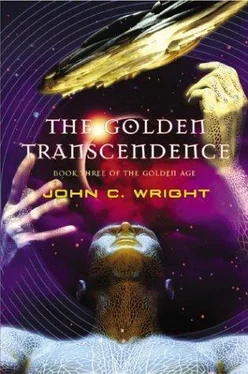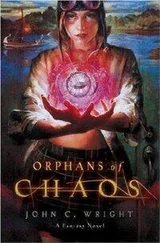The Hortators commanded a wide and precarious power, both economic and social, which they maintained by carefully retaining the goodwill of their subscribers. Many particular contracts had Hortator mandates written into the fine print, including clauses requiring the users to cooperate with embargoes and boycotts.
Because of the extraordinary lifespans of the Golden Oecumene peoples, the College could be staffed with what would have been, in earlier ages, culture heroes and historical figures, and, in the cases where no mental record survived, with ghosts or reconstructions.
ECONOMICS
The wealth of this era was so vast that it staggers calculation, and was distributed through a population that, though it far outnumbered the population figures of any previous era, was miniscule when compared to the resources scientific enterprise and industrial speculation had made available. The molecular machines of this era made materials which would have been waste products to men of previous ages into treasure mines. The amount of accumulated capital in the society, and the length of time over which capital ventures could extend before seeing a profit, increased the productivity of wage earners to the point where an average laborer, in real terms, controlled an amount of energy and resources that would dwarf the military budgets expropriated by governments of the warlike periods of the Third Era.
With robots to do all menial labor, and Sophotech to do all intellectual labor, the only category of economic activities open to mankind in the Golden Age was entrepreneurial speculation. In effect, man only had to dream of something that might amuse his fellow man. or render some small service, ameliorate some perceived imperfection in life, and command his machines to carry out the project, in order to reap profits to more than pay for the rental on those machines.
The immensity of the wealth involved, however, did not revoke any of the laws of economics known since antiquity. The law of association still proved that a superior and an inferior, when both cooperate and specialize, are more efficient working together than when working in isolation. No matter how wise and great their machines, humans always had more than enough to do. An extremely fine specialization of labor, including labor that, to earlier eras, would seem quite frivolous, allowed for nearly infinite avenues of effort to be utilized. The high population of the time was nothing but a boon; an entrepreneur need only reach the most tiny fraction of the public in order for his patrons to be numbered in the millions and billions.
Wage rates (which, by and large, were the rental rates of laboring machines) were allowed to fall to whatever level was needed to clear the market of labor; likewise for interest rates clearing the capital market. The evils and follies created by the interventions of governments into the market were unknown in the Golden Age; nor, among the long-lived people of that era, could doctrines based on short-term thinking or short-sightedness take root. There was neither unemployment (except as a penalty inflicted by the Hortators) nor capital lying idle, nor squandered. There was, of course, no central bank.
no debasement of currency, or other mischievous intermeddling with the economy.
Every great achievement of the superscience of the era, rather than sating the human desire for accomplishments, led to a wider threshold of what ambition could accomplish; and these greater powers led in turn to the desire for ever greater achievements. Engineering efforts that would have been impossible in the poverty of prior eras, including engineering on a planetary scale, were practical in the Golden Age.
NAMING CONVENTIONS
The complexity of the possible social and neurological arrangements into which the peoples and self-aware artifacts of the Golden Age could organize themselves was reflected in the diverse information carried by their formal names.
This information was usually carried in a header or prefix of standard electronic net-to-net communication, to allow the recipient to translate the response into a mutually comprehensible format and language. For humans using physical bodies, the names were translated into spoken syllables, usually in an abbreviated form.
The naming conventions were not entirely uniform, although most names would contain the same basic information, not necessarily in the same order.
For example, take the name Phaethon Prime Rhadamanth Humodified (augment) Uncomposed, Inde-pconciousness, Base Neuroformed, Silver-Gray Manorial Schola, Era 10191 (the "Reawakening").
"Phaethon" is the name of his outward identity, his public character. This only roughly corresponded to the Christian name (or first name) of an earlier age; it was a piece of intellectual property that could be bought and sold, and might also have copyright-protected facial features and expressions, body language, slang phrases, mottoes, or logos to go with it.
"Prime" indicates that he is the original copy of this mind content, not a partial, or a reconstruction, or a ghost. Among sequential iterations of the same consciousness, this is a sequence number. By the final era of the Golden Age, this name had fallen out of strict use, and many people listed fanciful numbers, such as Nought or Myriad.
"Rhadamanth" is the copyrighted reference to his genotype, that is, what the ancients would call a family name. In this particular case, Phaethon's family is named after his mansion. Both the genotype and mansion were created by his sire. Members of other schools would employ this name differently, or would leave it blank; but in general it was meant to reflect on the creator or parent, whoever was responsible for the existence of the entity. Among electronic entities, a time-depth, indicating whether the entity was permanent or temporary, would be added here.
"Humodified" is Phaethon's phenotype (modified human), which indicates that he is a biological consciousness, not electrophotonic, of a standard human ground-shape, compatible with the three basic aesthetics: Standard, Consensus, and Objective. The primary purpose of the phenotype name is to identify aesthetic compatibility.
An aesthetic identifies the symbols, emotional range, information formats, sense impressions, and operating speeds, and so on, with which the user is comfortable. Dolphins and Hullsmiths, for example, have additional ranges of vision, sonar, and hearing, plus several artificial senses that exist only in computer simulation, and consequently their ideograms can be written across a wider range of the electromagnetic spectrum.
"(Augment)" specifies additional phenotype information, and indicates that Phaethon carries standardized immortality nanomachines in his body. Note that Phaethon's name, when he opened his memory casket, would change to "(special augment)" to signify his nonstandard multiple modifications and adaptations for near-light-speed environments.
"Uncomposed" indicates a person's Composition or attachment to a cybernetic mind network-in this case Phaethon has none. Composed people who have independent or semi-independent consciousness would list their Composition name here. Fully Composed people list their Composition name as their first name, and might list here their function, or list here a designation describing the geometry of the Composition, i.e., radial, linear, parallel, serial, hierarchical, self-organizing, or unified.
"Indepconciousness" indicates Phaethon's nervous system is entirely self-contained. He is not linked into a mind-sharing scheme, a memory archive, a conscience monitor; he is not part of a mental hierarchy; he is not a synnoient or avatar; he is not emotion-linked, or sharing language midbrain structures. When Phaethon enters full communion with his ship, so-called navimorphosis, this name would change to reflect the mind-sharing scheme used.
Читать дальше










